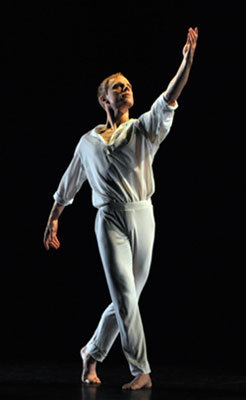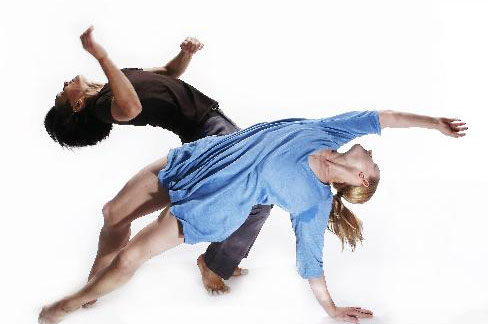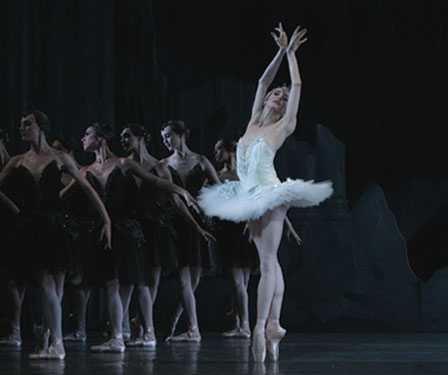Martha Graham Dance Company: Clytemnestra / Skirball Center, New York University, NYC / May 12, 15, and 16, 2009
Genius though she was–as a dancer, as a choreographer, and as the inventor of the only Western dance technique apart from classical ballet capable of training a dancer fully to professional capability–Martha Graham produced more than her share of weak, empty works, some of which even qualify as unintentional self-parody. There’s no question, though, that a cluster of her finest efforts belongs to what is known as her “Greek Cycle.”
Any susceptible dancegoer who has seen Cave of the Heart (1946), sprung from the myth of Medea and Jason; Errand into the Maze (1947), a gloss on the Ariadne and Theseus tale; or Night Journey (1947), which retells the Jocasta and Oedipus tragedy–when these works are rightly performed–knows he is looking at the soul laid bare. (Mentioning Graham’s rendition of these couples’ stories, I put the woman’s name first, because Graham saw human experience from a woman’s point of view–in other words, hers.)
This season, the Graham company, which has long known troubles almost worthy of the Greek myths, and is now led by Janet Eilber, has brought Graham’s recently revived 1958 Clytemnestra to New York. Derived from Aeschylus’s Oresteia and given a flashback-and fragmented treatment of time, the piece was a must-see at its creation, yet has been absent from the repertory since 1994.
Preview announcements for the troupe’s May 12-16 engagement at NYU’s Skirball Center (during which the piece was shown three times) as well as reviews from out of town, repeatedly described the work as the acme of Graham’s Greek-related dances. Why? Because it’s program-length, while the others I mentioned are succinct enough to be performed with two other works? Because its ruthlessness is positively gaudy? Many of the seven deadlies are covered and, Lord knows, the blood does flow, but violence, though it may contribute to grandeur–see The Iliad and The Song of Roland, literature that made me, a pacifist, understand the heroism and glory embedded in war–is not necessarily its equivalent. No, Clytemnestra can’t claim to be among Graham’s greatest Greek ventures; it’s simply a helluva melodrama, filled with extremes of action, but short on depth, texture, and subtlety of emotion.
The company calls its present production a reconstruction. What does that mean? It usually means that the dance in question is recalled and remounted by means of first-hand evidence: memories of the people on whom it was made; dance notation scores; film or video of its premiere or early showings; still photographs; notes penciled into the score as aide-mémoires by the work’s original rehearsal pianist; eye-witness accounts of early performances. Of course you see that these sources are listed in order of diminishing reliability, that they are incomplete and often shaky; and that, as time passed, the choreographer herself may have made changes in the dance.
So what have we got in the case of the present Clytemnestra? Something close to the original, claims Eilber, who had advisors that included company veteran Linda Hodes; a version that runs two and a half hours as it did when the dance was first created, compared, by radical example, to the 90-minute show shortened for a Dance in America telecast in the late 70s; the original costumes designed by Graham and dancer Helen McGehee, in place of the Halston outfits imposed upon the piece at one point; the original score by Halim El-Dabh, rife with voiced exclamations like “A mother’s curse!”; the semi-abstract sculptural set created by Isamu Noguchi, whose innovations for earlier and far greater Graham works (among them Frontier; Seraphic Dialogue, and Cave of the Heart) are legendary, but who, for Clytemnestra, just feebly quoted himself.
The choreography reveals Graham quoting herself, too, with moves that are gorgeous–huge strides, with the heels pounding the floor like muffled blows; slow, fluid back falls that require thighs of iron and a snake-supple spine; hands rigidly cupped or emphatically striking the body. These were radical when Graham invented them years before, but cannot astonish here because she appears to be repeating them merely by rote, without the context that would make them fully expressive.
Expression is, indeed, the main issue here. On opening night in New York, it was obvious that the dancers had been rehearsed within an inch of their lives. Now they need to loosen up and, stylized and formal though the choreography is, allow themselves to look like individual people, each one in the throes of his or her particular passion. A few have already achieved this: Maurizio Nardi as Aegisthus, primarily, and also Blakeley White-McGuire as Cassandra and Lloyd Knight as Paris. Nearly all of the others, technically magnificent, I grant you, are working as if they were aiming for a perfect score on the SATs. The Furies–a small chorus of women in black–move in a unison so precise, they look like the Rockettes.
The big disappointment was Fang-Yi Sheu, for several years thought to come close in power and expression to Graham herself. Her incarnation of Clytemnestra shows that, wonderful as she is, this was never really so–that she lacks the seething passion that gave Graham’s dancing its incontrovertible conviction and edge. As the tempestuous queen, Sheu is simply too weak in the departments of rage and lust, to say nothing of sheer athletic power. (Granted, a serious injury incurred a few years back may be responsible for this last.)
One of Eilber’s “bright ideas” to make the dance accessible to the present-day audience involves small changes in the choreography. These are a mistake, unworthy of Graham’s stern and vivid aesthetic, and should be dispatched to Hades immediately. Another is the addition of supertitles explaining who’s who and what they’re about at the moment. These should be unnecessary if the audience can be persuaded to read the program notes. The titles are tackily executed both physically and content-wise (the silly “Clytemnestra dwells on all that has happened,” for instance) and inevitably suggest dumbing down. What ‘s more they’re interspersed with signage like “Pause. 2 minutes,” which leads you to expect “Restrooms to the left. Canteen to the right.”
But the really grave problem with these ostensibly helpful messages is that they point out all too pertinently the fact that the dance itself doesn’t tell you what you need to know. I’m reminded of a long-ago colleague who, confronting performances of early postmodernism, forbid himself to read any program notes until he was returning home on the subway. Invariably, beneath the rattle and screech of the clattering train, he’d find himself exclaiming sotto voce, “Oh, so that’s what it was about!”
Despite my cavils, I’m very glad Clytemnestra is back in the repertory. When a dance is absent, it is soon forgotten. Present, it’s there for the rising generation to learn and interpret. As for the current cast, I am fairly confident that, with ongoing performances, the dancers will make it their own.
© 2009 Tobi Tobias








